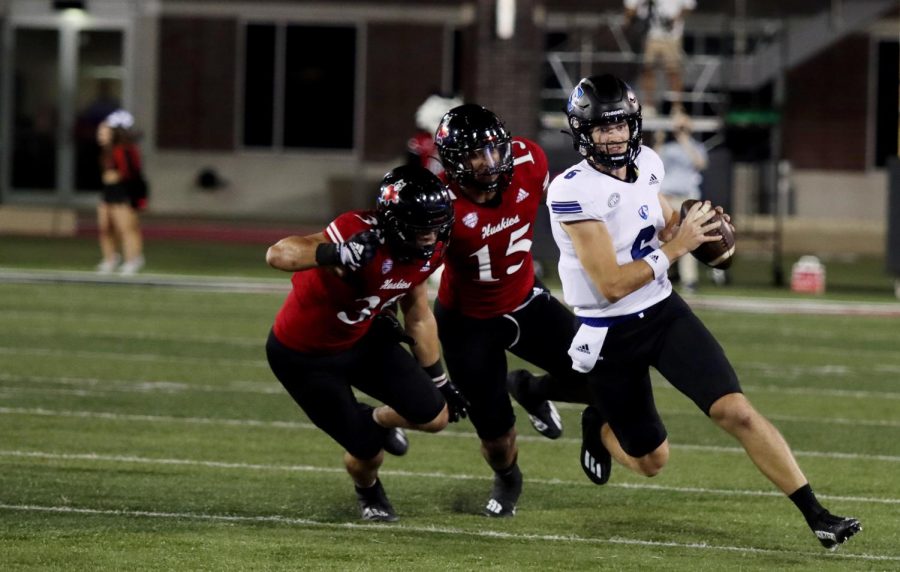Football equipment manager talks equipment costs
Number 6, Jonah O’Brien a redshirt sophomore quarterback runs the ball during the Panthers’ season opener against Northern Illinois University at Huskies Stadium Thursday night. The Panthers lost 34-27 against the Huskies. O’Brien threw 25-of-34 passing for 276 yards with three touchdowns.
September 7, 2022
The cost of equipment for a college football game day is undeniably costly and for the Eastern football team, it may be more than what some think.
Coordinator of equipment and stadium facilities for the Panthers, Clint Bays, provided a breakdown for each piece of equipment and their cost:
– Helmets: $425
– Shoulder pads: $325
– Game jersey: $160 (retail)
– Game pants: $100 (retail)
– Cleats: $120 (retail)
– Padded girdle: $50
– Socks/knee pads/compression top/wrist bands: $60
Breaking that down even further, it costs a little over $1,200 to equip each active player per game day. Bays said that helmets are the most expensive, but they provide technology needed to protect each player.
“Helmets are definitely the most expensive. Our helmets have sensors (Insite technology) that alert the athletic trainers when a player has an intense impact,” Bays said.
“It will tell the athletic trainers how severe the impact and to what region of the head the impact took place. It also allows us to have a weekly analytics report of the total impacts per player and the severity of the impacts. It can be done per player or by position group.”
There are a total of 22 players on and off the field during a regular football game, 11 players on offense and 11 players on defense.
With the cost of equipment at a little over $1,200 per player per game, the cost of equipment per game, in total, is a little over $27,000.
There are 11 games in the regular season, therfore, it costs a little over $300,000 each season to fully equip each active player and non-starters.
Safety standards set in place by the NCAA may create the need to purchase more pieces of equipment, adding to the yearly cost for equipment.
Bays said that the team has the support of the athletic administration to purchase necessary protective equipment.
“Our program has the support of our administration, and we are proactive in trying to purchase safe equipment for the athletes,” Bays said. “We have always tried to stay ahead of the safety standards set in place by the NCAA.”
In addition to the initial purchasing of the equipment, there is also time and effort put into maintaining the equipment.
Bays said that maintaining the equipment daily requires special attention.
“There is continual maintenance on most everything including proper cleaning, all parts and pieces inspected,” Bays said.
“Game jerseys and game pants all have to be laundered with special care.”
There comes a time when the equipment needs to be replaced in order to keep up with safety protocols.
Bays provided a breakdown of when the equipment needs to be replaced and said that it can vary due to amount of use and the position of the player.
– Helmets: can be recertified for 10 seasons but are usually replaced after 5-7 years.
– Shoulder pads: normally last 5-10 years depending on usage and player position.
– Jerseys: replaced every 2-3 years.
Autumn Schulz can be reached at 581-2812 or at acschulz@eiu.edu





![[Thumbnail] Eastern's Old Main was quiet Thursday morning while educators who had left the office to strike picketed outside.](https://www.dailyeasternnews.com/wp-content/uploads/2025/04/Strike_01_LT_O-800x1200.jpg)











![[Thumbnail Edition] Senior Foward Macy McGlone, getsw the ball and gets the point during the first half of the game aginst Western Illinois University,, Eastern Illinois University Lost to Western Illinois University Thursday March 6 20205, 78-75 EIU lost making it the end of their season](https://www.dailyeasternnews.com/wp-content/uploads/2025/03/WBB_OVC_03_O-1-e1743361637111-1200x614.jpg)






















































